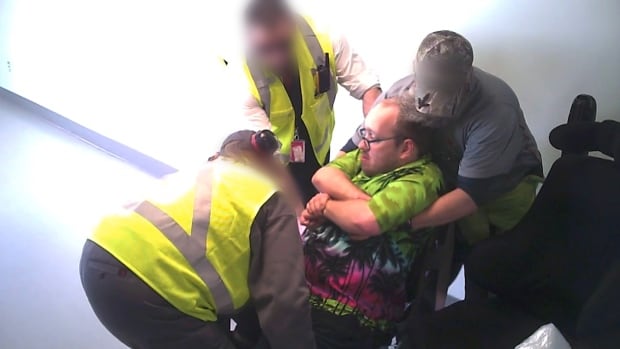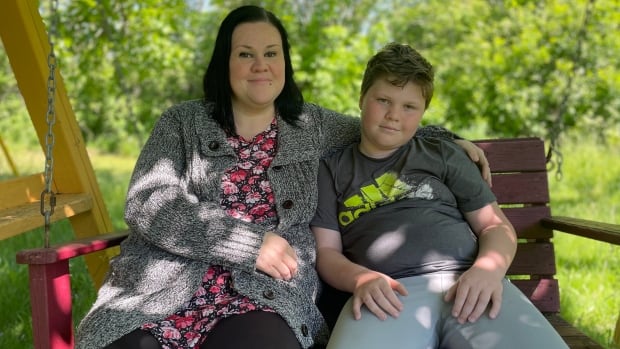As It Happens7:22His cancerous voice box was removed. Now he’s speaking again
Only a few months ago, Marty Kedian of Haverhill, Mass., couldn’t speak a word — and he didn’t know if he ever would again.
But, in February, Kedian received a total larynx replacement following a laryngeal cancer diagnosis and years of surgeries.
“I had an 82-year-old mother that I couldn’t talk to on the phone. And I talked to her the other day, and she could hear every word I said,” Kedian told As It Happens guest host Peter Armstrong.
It’s been four months since his transplant at the Mayo Clinic in Phoenix. He’s still hoarse and says it’s difficult to speak at times, but he can do it.
“Every time I talk about it, I can’t believe that’s happened,” said Kedian.
The 59-year-old is only the third person in the United States to receive a total larynx replacement, according to the Mayo Clinic.
The non-profit American academic medical centre says this is the first-known case performed on a patient with active cancer. It’s part of a clinical trial that Dr. David Lott, who leads the Mayo Clinic’s larynx and trachea transplant program, hopes can lead to more successful surgeries.

Lott and his team published the results from the clinical trial on Tuesday in the journal Mayo Clinic Proceedings.
“Just having this conversation and having this problem recognized for people, I think, gives hope and knowledge that they’re not alone out there,” said Lott.
The surgery
Before being diagnosed with cancer, Kedian considered himself a talker. He loved to make friends and talk to new people.
But, in 2013, he found he was having trouble swallowing his food. At first, he thought it was allergies and didn’t think much of it.
A series of tests found he had a rare form of laryngeal cancer called chondrosarcoma.
That led to surgeries. His first operation in 2014 was the start of dozens more over the next 10 years.
Eventually, the surgeries left his voice raspy and barely audible. When he couldn’t breathe on his own, a tracheostomy tube was inserted through a hole in the front of his neck so he could breathe.

“It was horrible when I lost my voice. I couldn’t talk to my friends, my family, my granddaughter,” said Kedian.
“You don’t want to go around people because they can’t hear you. When you try to talk, the only words you hear all the time is ‘what.'”
He was told his final option was to have his larynx, also called the voice box, removed. But Kedian refused and sought the help of Lott at the Mayo Clinic. Lott and his team had been investigating ways to restore and save a person’s voice. Kedian had hope.
According to the Mayo Clinic, laryngeal transplantation comes with significant risks, especially with the use of immunosuppressive therapy, which reduces the risk of organ rejection, but also lowers the body’s immune system response. That increases the risk cancer could spread.
But on Feb. 29, he went in for surgery. The procedure required six surgeons and lasted 21 hours. Their first priority was to remove the cancerous larynx.

The surgeons were then able to transplant the donated larynx, along with the adjoining tissues and tiny blood vessels to supply them. Surgeons used microsurgical techniques to connect nerves critical for Kedian to feel when he needs to swallow and to move the vocal cords, according to the Mayo Clinic.
“I’m amazed,” said Lott. “Remember, we’re listening to someone speak that’s just a little over four months out from having essentially his entire throat transplanted.”
More recovery to go
Kedian says the diagnosis and loss of his voice had a significant impact on his quality of life.
“It makes you feel like less of a person when you don’t have a voice,” said Kedian.
Since the surgery, he has about 60 per cent of his voice back. He can now swallow and breathe on his own. Doctors say his speech will continue to improve over the next year.
“The fact that he’s having this much function return in this short of a time has far surpassed what my expectations were,” said Lott.

And Lott says the success extends beyond Kedian’s recovery. He says they’ve been able to learn from Kedian’s journey, and hopes this option can be made available to more people.
But Lott says there is still more work to do.
“How do we do this safely in people that have lower-grade cancers and then eventually kind of higher-grade cancers, so that they don’t have to go through the suffering of having to have their voice box removed,” said Lott.
“Better days are coming and we’re just working on getting there.”





